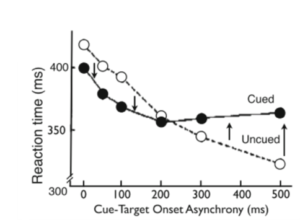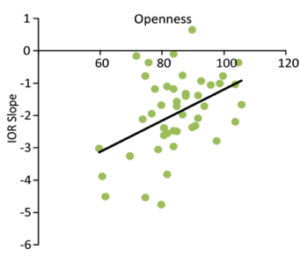Most would agree that that taking an interdisciplinary approach to studying the mind and brain is a necessity. Yet, as practicing scientists we often find ourselves in decidedly disciplinary bubbles: reading specific journals, and relying on theoretical constructs and methods that we are most familiar with.
In a new study published in Attention, Perception, & Psychophysics, Kristin Wilson and colleagues break out of all disciplinary bubbles and report a striking relationship between two constructs that are rarely seen together: personality and basic attentional processing. The authors report that people who have more open personalities—characterized by imagination, enjoyment of abstract ideas, adventurousness, and dislike of routine—show a considerably weaker inhibition of return.
Inhibition of return refers to the relative difficulty in attending to previously attended locations again, compared to attending to new locations. It is a general attentional phenomenon first described in human adults, but since observed in infants, non-human primates and even in the water-jet shooting archer fish:
[youtube https://www.youtube.com/watch?v=4T1SQtavaUM]
This generality supports the proposal that inhibition of return may be an evolutionarily old attentional mechanism for enabling more efficient foraging.
The classic way to measure inhibition of return is to use a probe detection task. It works like this: First, participants see a cue—a dot or rectangle marking some position. Then, after a delay, a probe—another dot—appears in either the cued location or someplace new. All participants need to do is press a button as soon as they see this probe. The typical pattern of response times is shown below: when the delay between the cue and target is fairly short, the cue speeds responses (a cue-facilitation effect). But at about 200 ms there’s a switch and people are inhibited to return to the previously cued location, hence the name. (Incidentally, a recent paper by Dukewich and Klein in Attention, Perception, & Psychophysics explores the varied definitions researchers have of the Inhibition of Return phenomenon).

Wilson and colleagues used a version of this task (see schematic below) to measure individual differences in how inhibition of return was spatially distributed. A more diffuse inhibition patern would show up as similar times to probes that were near and far from the cued location. Prior to doing this task (more than 1000 trials of it!), participants were asked to fill out a validated personality questionnaire designed to measure the “big five” personality traits: extroversion, neuroticism, openness, agreeableness, and conscientiousness.

The results, shown below, reveal a clear relationship: individuals who are more open, have a more diffuse pattern of inhibition of return. More open individuals were not overall better or worse on the task, but rather were less resistant in returning to the same locations after being cued to it (i.e., their reaction times increased more gradually as the probe neared the previously cued location).

Given the general nature of inhibition of return, it is surprising to find that its extent appears to be related to something as high-level as a personality trait. But studies like these are precisely what is needed to bring us closer to bridging the still wide gulf between basic perceptual and attentional processes and much more complex constructs like personality traits. Although the results are purely correlational, they raise the (admittedly speculative) possibility that initially small differences in attention may snowball over time to produce the kinds of differences we associate with differences in openness—that some of us might enjoy strange art while disliking watching the same movie again.
It is worth asking why studies investigating the relationships between basic perceptual constructs and high-level ones like personality are not more common. Kristin Wilson, the lead author of the study, suggests that “Each field has their own set of assumptions and terminology and questions they feel are important.” Well put. But thinking about what leads us toward or away from studies that bridge basic vision science with personality psychology raises another question: why are some researchers attracted to studying basic attentional phenomena like inhibition of return and others attracted to studying topics like personality? Perhaps small initial biases in how we respond to new information nudge us in still unknown ways to favor certain kinds of topics over others.
Article discussed in this post:
Wilson, K. E., Lowe, M. X., Ruppel, J., Pratt, J., & Ferber, S. (2016). The scope of no return: Openness predicts the spatial distribution of Inhibition of Return. Attention, Perception & Psychophysics, 78,209-217. doi:10.3758/s13414-015-0991-5.
